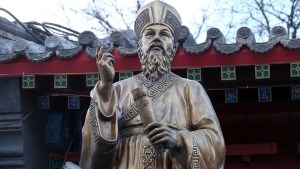Pope Francis on Wednesday advanced the cause of sainthood for Sister Eliswa of the Blessed Virgin Mary. Previously recognized as a Servant of God in 2008, now Sister Eliswa, foundress of the first indigenous congregation for women in India, has been granted the title Venerable.
Sister Eliswa of the Blessed Virgin Mary was born Eliswa Vakayil, in 1831, the first of eight children. According to a website dedicated to Sr. Eliswa’s life, she showed a keen interest in prayer and sacrifice even as a child. By age 16, she was married to a man named Vatharu Vakayil, with whom she had a daughter, Anna. Unfortunately, Vatharu fell ill not long after and passed away.
While a second marriage was suggested to Eliswa, she instead chose to immerse herself in a life of silent prayer and service. She began to make frequent visits to her Catholic parish in Koonammavu, where she attended adoration of the Blessed Sacrament and surrendered herself wholly to the Holy Spirit.
In 1862, after a time of intense prayer before the Blessed Sacrament, Eliswa approached Rev. Fr. Leopold Beccaro O.C.D. and explained her desire to consecrate her life to God. She then entered a period of trials and tests that lasted four years, during which time she was joined in her vocational discernment by her youner sister Thresia and daughter Anna.
All three were received into the Carmelite order in 1866, when they moved into a newly built bamboo convent that became the foundation for the Community of Teresian Carmelites (C.T.C.). This was the first convent ever built in Kerala, but the bamboo structures were insufficient and a two-story convent building was soon commissioned at St Teresa’s Convent at Koonammavu.
In 1887 the Syrian Catholic Church in Kerala was separated from the Latin hierarchy by Pope Leo XIII, which meant the convent in Koonammavu was separated from the jurisdiction of the Archbishop of Verapoly. While this arrangement of the rites was supposed to be peaceful, the Latin-rite nuns were eventually asked to leave.
A new convent building in Varapuzha was blessed on Tuesday, November 11, 1890, and Sr. Eliswa and her Community had their permanent residence in their second Mother House, St. Joseph’s Convent, Varapuzha.
Today the two branches of this TOCD Congregation form two independent religious congregations: The Congregation of Teresian Carmelites (CTC), the Latin rite, and the Congregation of the Mother of Carmel (CMC), the Syrian rite.
Sister Eliswa of the Blessed Virgin Mary passed away on July 18, 1913, and was buried at the Basilica of Our Lady of Mount Carmel and St. Joseph. Her remains would later be moved to the tomb chapel called Smruthi Mandhiram at St. Joseph’s Convent of CTC at Varappuzha. The site has since become a popular place of pilgrimage.
Click here to learn more about the life of Venerable Eliswa of the Blessed Virgin Mary.
Click below to learn about the various “rites” in the Catholic Church.
~
In the Catholic church there are several steps to becoming a saint, beginning with being named a Servant of God, which acknowledges that an individual led a holy life. According to the USCCB, a Servant of God may be elevated to the Venerable status if they are found to have exhibited “heroic virtue” during their lifetime. In order to be beatified – named Blessed – a rigorous investigation is conducted into the life and writings of an individual and a miracle attributed to the individual’s intercession must be proven.





